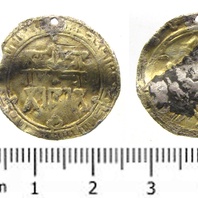
Viking Objects
Samanid Silver Dirham Pendant (LCNCC:2014.16)
An Arabic silver dirham minted c. 905-906 (Hijra 293) for the Samanid ruler, Isma’il ibn Ahmad (849-907), that has subsequently been pierced and gilded so that it could be worn as a pendant. It was probably minted in Balkh, Afghanistan. The Vikings often repurposed items like this. The dirham was a unit of weight used across North Africa, the Middle East, and Persia, with varying values which also referred to the type of coins used in the Middle East during the Viking Age. These coins were extremely prized possessions not only for their silver value but as a way of displaying one’s wealth and vast trade connections. Millions of Arabic dirhams would have been imported throughout the Viking world and are mostly found in hoards.
Read More
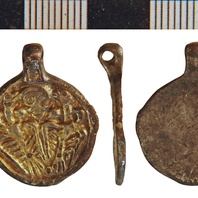
Viking Objects
Pendant with an Odin Motif (NLM-7F954A)
A cast silver, gilded pendant featuring an image which has been interpreted as representing the one-eyed god Odin and his two ravens Huginn and Muninn. There are a number of close parallels which establish the wide currency of this subject group. These include numerous examples from Russia and two from Sweden, including some with silver gilding. A silver pendant with a related, but distinct design is known from Sjælland, Denmark. With some exceptions, pendants were generally worn by women as part of their Scandinavian dress.
Read More
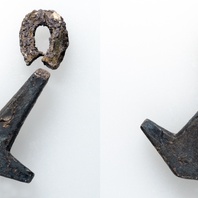
Viking Objects
Thor’s Hammer Pendant (1989-59/7224)
A silver hammer-shaped pendant found in Grave 511 at Repton. This is the grave of a man who appears to have died violently, taking a vicious cut to his loins. These may have been worn to show devotion to the god Thor, or to secure the god’s protection, although there is little evidence to support this interpretation. Pendants like this have been found made of lead, copper alloy, silver and gold, showing that many different strata of society could have worn them.
Read More
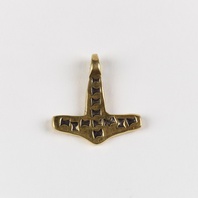
Viking Objects
Reproduction Hammer-shaped Pendant
A gold hammer-shaped pendant, popularly called a Thor’s hammer pendant, from Spilsby, Lincolnshire. These may have been worn to show devotion to the god Thor, or to secure the god’s protection, although there is little evidence to support this interpretation. Pendants like this have been found made of lead, copper alloy, silver and gold, showing that many different strata of society could have worn them.
Read More
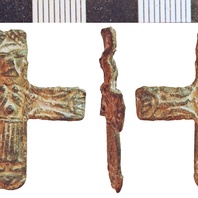
Item
Crucifix Pendant (NLM-AD60CD)
The settlement of Scandinavians in the Danelaw inevitably led in the end to their conversion to Christianity, though how this process happened and how long it took varied in different parts of the country and is still not fully understood. Finds from Scandinavian-settled areas, like this crucifix with a clear image of Christ on the cross, may well be evidence for this process.
Read More
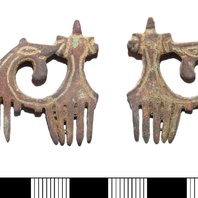
Viking Objects
Comb Pendant (LIN-DD07D2)
The pendant is decorated with two inturned zoomorphic heads executed in Ringerike-style ornament. These comb-shaped pendants are closely paralleled in the area around the Baltic Sea such as northwest Russia, Finland, Latvia and Lithuania, with rare examples from Estonia and Sweden. Pendants were a popular dress accessory in Norway and Sweden and sometimes were worn with beads between a pair of oval brooches. In England, pendants did not have the same popularity and there do not seem to be any contemporary Anglo-Saxon pendants.
Read More
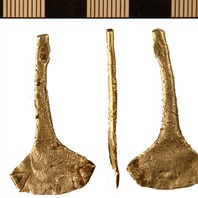
Viking Objects
Probable Thor’s Hammer Pendant (NLM-1A6811)
These may have been worn to show devotion to the god Thor, or to secure the god’s protection, although there is little evidence to support this interpretation. Pendants like this have been found made of lead, copper alloy, silver and gold, as well as other materials, showing that many different strata of society could have worn them. For more information on Scandinavian jewellery in England check out our blog: Brooches, Pendants and Pins: Scandinavian Dress Accessories in England.
Read More
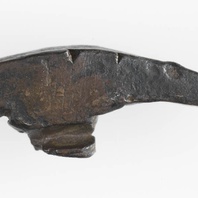
Viking Objects
Silver Thor’s Hammer Pendant (CM_1841_2008)
This is a high quality hammer-head section of a silver Thor’s hammer pendant. These may have been worn to show devotion to the god Thor, or to secure the god’s protection, although there is little evidence to support this interpretation. Pendants like this have been found made of lead, copper alloy, silver and gold, showing that many different strata of society could have worn them. For more information on Scandinavian jewellery in England check out our blog: Brooches, Pendants and Pins: Scandinavian Dress Accessories in England.
Read More
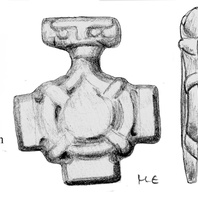
Viking Objects
Die Stamp (NLM-690F57)
This cast copper-alloy die was used in the process of making filigree pendants of the Hiddensee-Rügen type, more specifically, to create pressed silver or gold sheet appliqués, which were applied to a pendant back-plate and used as a base for filigree and granulation work. The ring in the centre creates a closed ring-knot motif related to the Scandinavian Borre style. The Hiddensee-Rügen style is named after the gold jewellery hoard discovered in the late nineteenth century on the island of Hiddensee, off the Baltic coast of Germany. The Swinhope die is one of a small group of recorded objects used in the production of Hiddensee-style cruciform pendants. No finished pendants of the type represented by the Swinhope die are known, either from England or Scandinavia.
Read More
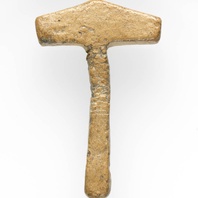
Viking Objects
Lead Thor’s Hammer Pendant (CM_569_2010)
A lead Thor’s hammer pendant with a trapezoidal head and pierced base. These may have been worn to show devotion to the god Thor, or to secure the god’s protection, although there is little evidence to support this interpretation. Pendants like this have been found made of lead, copper alloy, silver and gold, showing that many different strata of society could have worn them. For more information on Scandinavian jewellery in England check out our blog: Brooches, Pendants and Pins: Scandinavian Dress Accessories in England.
Read More
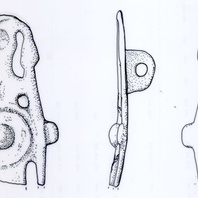
Viking Objects
Pendant (LEIC-C58A13)
This copper-alloy pendant depicts an individual holding a shield and a sword. Similar designs have been seen in pendants from southern Scandinavia which are generally identified as valkyries, though they could represent other mythological figures. The closest parallel in England is an example from Wickham Market, Suffolk. .
